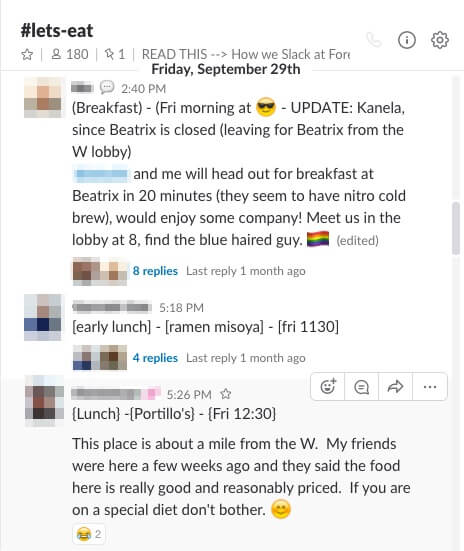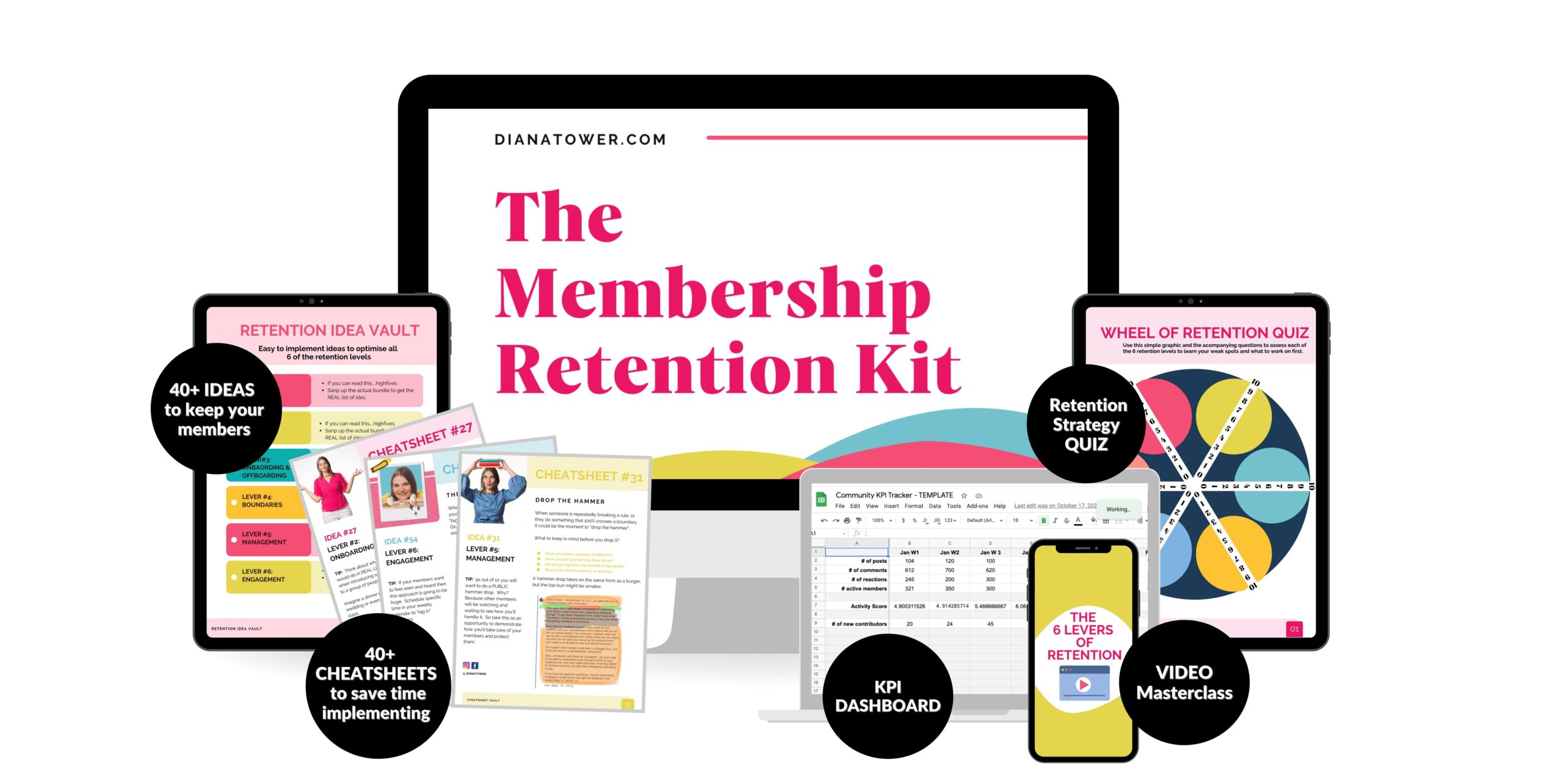Chapter 8 —
How much time each week do you realistically have/need to drive engagement?
Now, initially when writing this chapter I wasn’t going to give you a number. That’s right. I was convinced that it was 100% based on what time you have available to you. But…that’s not totally true.
There is a minimum that you (or someone official) need to invest in your community and here it is.
30 minutes a day, Monday-Friday.
That’s the bare minimum folks, but it’s not set in stone. When you are first establishing your community the key is to maintain your guidelines consistently so that your members learn the ropes.
This October I helped IWT manage their Slack community for their live event Forefront, in Chicago. I wasn’t involved in creating the group so I had to work with the channels I was given BUT I did know one thing…we had to establish the guidelines BEFORE the live event…when 500 attendees would be swarming Slack, looking for opportunities to meet up before, during and after the event.
In 2016 I remember the Slack community and it was a bit of a shit-show. Slack hadn’t introduced threaded replies at that point and it was really hard to keep track of conversations and set up meet ups.
I didn’t want the same to happen this year so I went on a mission to establish only 2 rules.
- Use threaded replies to keep the conversations in one place.
- Use a posting template for arranging meetups.
- [WHAT IT IS] – [WHEN] – [WHERE]
Rather than having a sea of “who wants to grab lunch?” posts, there were detailed posts that were easy to scroll through.
As people started using the community I would pop in and check on things. If someone didn't use threaded replies or the template I PMed them to ask them to update it but also explained why it was beneficial to them and the community.

I set the expectations BEFORE the event kicked off so that we could “set it and forget it”.
Now of course, during Forefront I wasn’t going to have time to be “in” the Accelerator community for almost 5 days. So what happened once Forefront kicked off?
First of all…I only checked in on the Accelerator community twice. Yup. That’s right. Two times in just under a week.
- Did all hell break loose? No.
- Did everyone start promoting their shit. No.
- Did the community “die”? No.
That’s the thing. When you establish the guidelines right off the bat and hold people to them consistently, you set the tone and foundation of the community so that you can step away from it without it going into cardiac arrest.
As for the Forefront Slack community, people could see that the templates and threaded replies made it easier and so each channel transformed into a buffet of meetup events.
Discover your “happy hours”.
Whenever faced with the question, “how much should I charge?” I’m always drawn to Michael Ellsberg’s fantastic article: “Your ‘Happy Price' vs. Your ‘Sad Price': How To Charge An Amount That Motivates You”.
In this article Michael walks us through a process for discovering what price point is the “sweet spot” for us emotionally, taking us from sad to happy, and I invite you to do the same for the time invested in your community.
I’ve already told you that you’ll need to spend at least 30 minutes a day (mon-fri) in your community, but what are you going to do long term? Are you going to dedicate more time?
In Michael’s article he focuses on price, but I’m going to change up the language a bit to make it apply to the hours spent in your community, and we want happy hours…cheers to that.
Imagine you ask me how much time it’s going to take to manage your community and I say;
“Hey dude, your course community is going to take you 20 hours a week to manage.”
Would you be happy, or sad, about that?
If you’d be sad (or doing an ugly cry) change the number. What about 10…5hrs?
Keep asking yourself this question until you find a number that makes you feel happy. THAT is your “happy hours” number. The number of hours that you would be happy to invest in your community without feeling overwhelmed or resentful.
I get it. You’ve got a lot of other things to do (content creation, customer service, guest posting etc). Community is only one piece of the puzzle, and finding how much time that piece takes is an important step to providing your students with an outstanding community.
How to create a schedule to implement your engagement strategy.
Now, this is important, so listen up so you don’t waste your time like I did.
When I first started managing communities, I was all over the place. I didn’t have a schedule, a strategy or a plan, I simply did what I thought our students needed and also what my consulting clients wanted me to do.
Don’t get me wrong, this worked for a while and did help me create amazing communities, but the part of the story that no one knew was how my life was falling apart.
I was always ON. I had Facebook on my phone and would always check in on the communities. While I was making dinner, while at the park with my son or even while we were all hanging out in the livingroom as a family.
There were no boundaries and these communities consumed my thoughts all the time. I loved these communities and the people in them, but it was seriously screwing up my marriage and my other relationships. Something had to give and I needed to set boundaries.
I don’t want the same to happen to you, and that’s why I’m writing this guide. It’s SO important to establish guidelines not only for your students but for YOU, so that you don’t end up a slave to your community.
The ONE thing that I did that changed everything was add ALL my community tasks into my Google Calendar. That way I could see where my time SHOULD be going and this also gave me permission to clock out.
Before doing this I would end up working about 8-10 hours days. Which is bonkers. I wasn’t supposed to be working that much but I couldn’t help it. I love the community members I work with (just like you love your students) and I wanted to be there for them…even if it meant sacrificing my relationships, my sleep and ultimately my life.
So here is what I’d recommend doing.
Write a list of everything that you’d like to do in your community. Perhaps that includes PMing all new students, answering questions in the community, showing appreciation for students that help others, highlighting wins from different students etc.
From that list, you’d divide up your time depending on which tactics you believe will have the most impact for your students.
For example:
If you have 5 hours a week to work in your community, you might divide things up like this.
- (2.5hrs) 30 minutes a day – Mon-Fri – PMing with new and existing students to ensure they are moving forward.
- (2.5hrs) 30 minutes a day – Mon-Fri – Answering questions, replying to tags and comments in the community..
That’s it. It sounds simple, but by creating a plan for yourself you can be consistent. This allows you to draw a line for yourself AND it also establishes expectations for your students.
Not sure what tasks are involved in managing a community? Grab this list that I wrote up for you. It lists ALL the things that I have ever done for a community so you can get a better idea of everything that could come up, that no one talks about.
BONUS MATERIAL: Grab your copy of the community task list
I'll also send you BOTH my ultimate guides (and bonus offer spreadsheets and systems) to help you engage the members in your online community.
Keep Reading...




